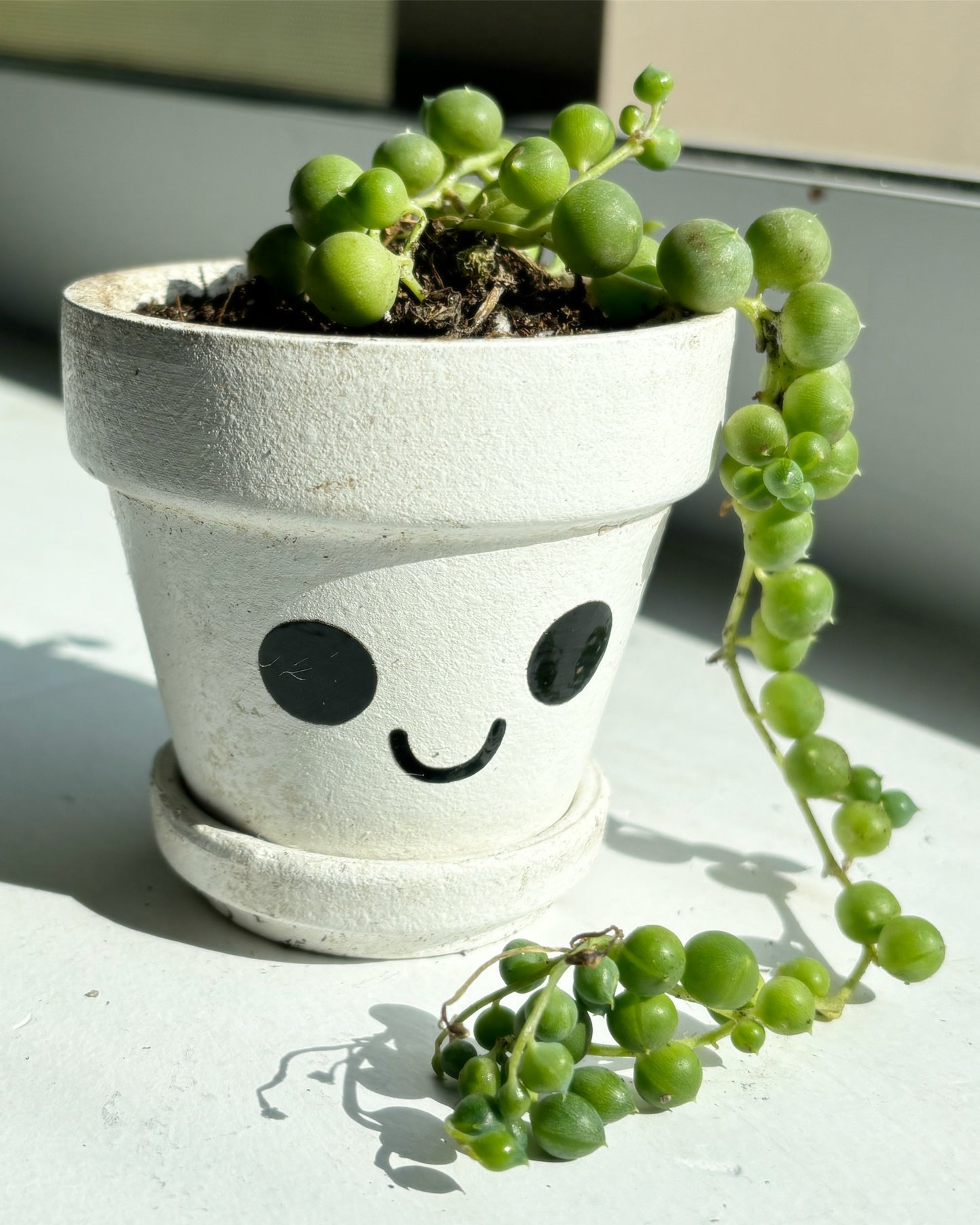Adorkable Emporium
Design Your Own Plant Baby - Live Plant
Design Your Own Plant Baby - Live Plant
Couldn't load pickup availability
How to Design Your Own Plant Baby:
Choose your vessel - pick a color that makes your plant baby stand out
Choose your MOOD - give your plant baby a little personality by choosing a face, , please refer to the Ani-MOOD Collection Gallery to choose your ID number
Choose your plant baby - choose the plant baby that calls to you
*Live Plant Babies come with a vessel with matching saucer, MOOD design, and plant baby of your choice.
Live Plant Babies to Choose From:
Aloe - *Potentially Toxic to Pets* - Soft succulents will not survive a hard frost, but if there is a risk of freezing temperatures they can be brought indoors to grow on a sunny window sill or under a grow light. They need bright sunlight, great drainage, and infrequent water to prevent rot. Pick containers with drainage holes and use well-draining cactus and succulent soil with 50% to 70% mineral grit such as coarse sand, pumice, or perlite. Water deeply enough for water to run out the drainage hole, then wait for the soil to fully dry before watering again.
Cactus - *Not Toxic to Curious Pets, but May Cause Skin Irritation* - These cactus varieties will not survive a hard frost, but if there is a risk of freezing temperatures it can be brought indoors to grow on a sunny window sill or under a grow light. Cactus need bright sunlight, great drainage, and infrequent water to prevent rot. Pick containers with drainage holes and use well-draining cactus and succulent soil with 70% to 80% mineral grit such as coarse sand, pumice, or perlite. Water deeply and wait for the soil to completely dry out before watering again.
Crassula - *Toxic to Pets* - Soft succulents will not survive a hard frost, but if there is a risk of freezing temperatures they can be brought indoors to grow on a sunny window sill or under a grow light. They need bright sunlight, great drainage, and infrequent water to prevent rot. Pick containers with drainage holes and use well-draining cactus and succulent soil with 50% to 70% mineral grit such as coarse sand, pumice, or perlite. Water deeply enough for water to run out the drainage hole, then wait for the soil to fully dry before watering again.
Echevaria - *Non-Toxic for Curious Pets* - Echeveria need bright sunlight to maintain their colors and compact rosette form. They will not survive a hard frost, but if there is a risk of freezing temperatures they can be brought indoors to grow on a sunny window sill or under a grow light.
Like most succulents, they need great drainage and infrequent water to prevent rot. Pick containers with drainage holes and use well-draining cactus and succulent soil with 50% to 70% mineral grit such as coarse sand, pumice, or perlite. Water deeply enough for water to run out the drainage hole, then wait for the soil to fully dry before watering again.
Gasteria - *Non-Toxic for Curious Pets* - Gasteria have low light and water requirements. They are one of the best types of succulents to grow indoors because they can tolerate low light conditions and still maintain their form and colors. Plant Gasteria in deep pots with drainage holes as they grow deep roots and will not tolerate standing water. Use a gritty, well draining soil and water deeply, but only when the soil is fully dry. Protect from frost.
Haworthia - *Non-Toxic for Curious Pets* - Haworthia are able to tolerate low, indoor light, making them excellent houseplants, even for beginners. They are particularly easy to grow and rarely affected by common succulent pests and diseases. Strong, drought-tolerant roots will grow if they have great drainage and infrequent water. Pick deep containers with drainage holes and a gritty, well-draining soil that is 50% to 70% mineral grit (coarse sand, pumice, or perlite). Water deeply enough for water to run out the drainage hole and allow the soil to completely dry before watering again.
This genus tolerates high heat by slowing down and eventually going dormant in the peak of summer. This means that, unlike other succulents, it is important not to over-water or fertilize during summer dormancy and water a bit more frequently in the winter growing season. Haworthia are slow growers and tend to stay small in pots, but they will produce new offsets in clumps around their bases. These offsets can be left to develop into a dense clump or pulled off and transplanted.
Sempervivum - *Non-Toxic for Curious Pets* - Hens & Chicks need plenty of outdoor sunlight to show their best colors and maintain a tight rosette form. They thrive in gritty, well-draining soils and pots with drainage holes. They produce new offsets or "chicks" on stolons. These chicks can be left to form tidy clusters or removed to share and transplant.
Sempervivum do most of their growing in the spring and summer, and will thrive with weekly watering and afternoon shade if temperatures exceed 80F. They are incredibly frost hardy and will happily thrive through winter under an insulating blanket of snow. Protect from heavy rains and standing water to prevent rot.
Senecio - *Toxic to Pets* - Soft succulents will not survive a hard frost, but if there is a risk of freezing temperatures they can be brought indoors to grow on a sunny window sill or under a grow light. They need bright sunlight, great drainage, and infrequent water to prevent rot. Pick containers with drainage holes and use well-draining cactus and succulent soil with 50% to 70% mineral grit such as coarse sand, pumice, or perlite. Water deeply enough for water to run out the drainage hole, then wait for the soil to fully dry before watering again.
Source: https://mountaincrestgardens.com/pet-safe-succulents/
Share

